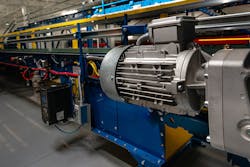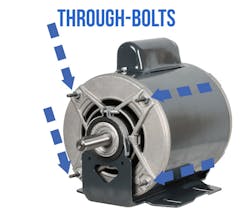Sometimes one-size-fits-all is a good idea, but other times some research can yield a better solution. A generic beanie cap might fit anybody, but a dress shirt needs to be the right size. For technical projects, one always wants the right component for the task at hand, and this is especially important for motors. A motor must be rated for the environment, be able to handle the load, and run efficiently and reliably.
Using the wrong motor will be inefficient at best, and unworkable at worst. On the other hand, not every design requires a high-end motor, and exceeding specifications can result in excessive costs.
For many industrial applications, the latest multi-purpose motors can meet a wide range of technical needs with a consolidated number of models. One such style is the open drip proof (ODP) motor configuration. Some manufacturers offer even more capable totally enclosed (TE) multi-purpose motors, which may be called various names such as “4-in-1” motors. Whether ODP or TE, multi-purpose motors can be specified to cover a wide range of applications, leading to efficiencies in design, procurement, and maintenance.
Consider the Environment and Application First
Understanding the conditions imposed by the environment and the physical needs of the equipment are crucial to selecting a motor construction offering good performance and longevity. A conveyor motor installed in a relatively cool, clean, and dry indoor warehouse location is a straightforward application (Fig. 1), but other installation environments can be much more challenging.
The three major environmental concerns are temperature, dirt, and moisture. Sometimes these factors can compound impacts and present additional issues. For instance, even when dirt doesn’t make it all the way into the inner workings of a motor, it can coat the surfaces and reduce cooling effectiveness, making the motor more susceptible to high ambient temperatures. Another environmental concern is vibration, whether from normal equipment operation or a less-than-perfect installation.
Any motor must mechanically mount to the driven equipment in a robust way, and multiple mounting styles and orientations are possible in most applications. Another consideration is that many users are moving to variable frequency drives (VFDs) for improved control, reduced equipment wear, and energy savings. However, a motor should be specifically rated for VFD service to avoid premature failure.
Very specialized motors can be obtained to meet the environmental and applications needs. But for many cases, users may find that a few models of multi-purpose motors can cover a wide range of applications.
ODP Can Be the Simple Solution
For everyday industrial or commercial motor applications without environmental concerns of water and contaminants, ODP motors are often the simplest and most cost-effective solution. ODP motors are constructed with open vents to send air directly over the windings (Fig. 2). This makes them less expensive to manufacture and able to run cooler than enclosed motors. Sealed bearings are used to avoid damage from airborne contaminants at the spinning shaft.
ODP motors are most suitable for dust-free or low dust environments with no water splashing or spraying. However, these designs can be safely used in areas where water may drip on the motor.
Multiple mounting options are available for ODP motors, such as a baseplate and through bolts. Resilient bases make for simple and direct mounting while providing enough flexibility for various uses. Keep in mind, however, that ODP motors are not likely to be VFD-rated.
ODP motors are more economical for the initial direct purchase, and they also run cooler and can therefore use less energy than a motor requiring a cooling fan, cutting operating costs and maintenance expenses.
More Capable Multi-Purpose Options
Due to better water resistance and enclosed operation, TE multi-purpose motors are generally better suited to challenging environments than ODP motors. Multi-purpose motors can meet multiple requirements in operation by incorporating the most sought-after combinations of features (Fig. 3).
Some key TE multi-purpose motor features include:
- Flexible mounting
- Continuous-duty air-cooling
- Reversible operation at various voltages
- Higher grade electrical windings
These motors also accommodate all the typical mounting options needed to use the motor effectively. These options include a C-face mounting ring, bolt holes, and a bolt-on removable rigid base, providing flexibility for mounting at any angle in addition to typical horizontal and vertical installations.
From an environmental standpoint, these TE motors are rated to run continuously while being cooled by ambient air. TE construction prevents contaminants from entering the motor. More specifically, these motors are usually totally enclosed fan-cooled (TEFC). These TEFC motors are closed to the environment, meaning they are not affected by airborne dust or other contaminants, or else by wind-driven water or rain. A TEFC motor provides its own cooling via an external fan attached to the rotating shaft. Some motors are available with drip cover kits for extra protection.
For these motors an additional important requirement is to ensure the motor is VFD-rated if it will be operated in these types of applications, as opposed to simply being suited for standard general purpose (GP) induction across-the-line starting. VFD-rated motors may also be called inverter duty or vector duty.
If a TEFC motor is used with a VFD, care must be used to limit the lowest operating speed to be equal or greater than the rated minimum speed required for adequate cooling in the environment and application for which the motor is specified.
VFD-rated motors incorporate electrical windings suitable for the service. Some motors achieve this using CR200 Corona Resistant magnet wiring, which allows for traditional GP across-the-line starting as well as VFD operation. CR200 wire has higher insulation values (F Class insulation on most designs), and the motors are manufactured using wiring methods designed to secure the windings from vibration. These features allow the motor to be protected from the waveforms produced by VFDs, and they provide many years of reliable operation when used within the motor’s design criteria.
Fewer Motor Styles, More Applications
Motors are relatively high-dollar elements of equipment, so end-users and OEMs are rightfully very aware of their motor expenditures. The ability to specify multiple-use motors becomes more appealing as users consider managing fewer parts in their purchasing systems, engaging with a smaller number of vendors, and needing less storage space. These benefits are realized during the initial design and manufacturing process, and also later for support and maintenance.
There is some overlap in these typical applications for ODP and TE multi-purpose motors:
- Machine tools
- Conveyors
- Packaging machines
- Batching equipment
- Food and beverage systems
- Pumps
- Fans
ODP motors provide the most economical way to meet application needs in warehouses, cleaner manufacturing areas, dry basements, and other benign environments.
For applications with any amount of dirt or with dispersed water, or where VFDs are used, TE multi-purpose motors are generally considered to be the most viable upgrade option over a basic ODP motor. Due to their enclosed nature, these motors may deliver a longer operating life.
Specifying Just Enough Motor
End-users and OEMs alike can benefit by choosing multi-purpose ODP and TE motors, where just a few stock types can satisfy many applications while minimizing inventory. Streamlining the number of motor types specified enables the best use of resources, while still providing long-lasting and unimpeded service. A little time spent in the motor specification process saves money and can simplify design, purchasing, stocking, and maintenance.
Bryan Sisler is the product manager for Drives and Motors at AutomationDirect. He has been involved in the automation and the electrical/electronic field for 35 years.



